The last thing we want anyone to think is that if they’re over 35, fitness is out of their reach. There are countless folks in that “Masters” age group lifting hundreds of kilograms and competing at elite levels — yes, over 35 is considered “Masters” for most strength sports, and no, that’s really not even that old. Most strength sports have divisions based on age, often in increments of 5 years — so 35-year-olds usually aren’t competing with 65-year-olds — as well as classes for gender and bodyweight.
But what we really want to focus on is how being a regular old amateur who takes up strength sports as a hobby — like your buddies who play pickup basketball or football — can experience huge benefits to their physical and mental health.
Strength sports are one of the best ways to get your bone strengthening exercise, the aesthetic benefits of fitness, and even improve sleep and reduce stress. We’re outlining here why, as you becoming increasingly aware of the importance of exercise, you’d like it to be fun, goal-oriented, communal, and have the option of competing if you so choose.
- What Are Strength Sports?
- Benefits of Strength Sports for Older People
- Training Considerations for Masters Athletes
- Outside of the Gym
- Finding a Coach
- Resources for Masters Athletes
Editor’s note: The content on BarBend is meant to be informative in nature, but it shouldn’t take the place of advice and/or supervision from a medical professional. The opinions and articles on this site are not intended for use as diagnosis, prevention, and/or treatment of health problems. Speak with your physician if you have any concerns.
What Are Strength Sports?
There are many strength sports out there (even wife carrying is in this category), but there are four main ones you’re most likely to come across and there are four we’ll focus on in this article.
Powerlifting
Simply put, the athlete gets as strong as they can in the squat, bench press, and deadlift. At powerlifting competitions, or “meets,” you get three attempts at each lift to get the highest “total” they can. (That’s the heaviest weight successfully lifted in each movement, all added up.) Like everything else on this list competing is entirely optional, but many find it helpful to have meets — or just heavier lifts they perform on their own — as goals. (More on that later.)
Powerlifters usually don’t focus much on cardio, although cardio is useful for improving blood oxygenation and recovery time between workouts, plus it’s just good for your health.
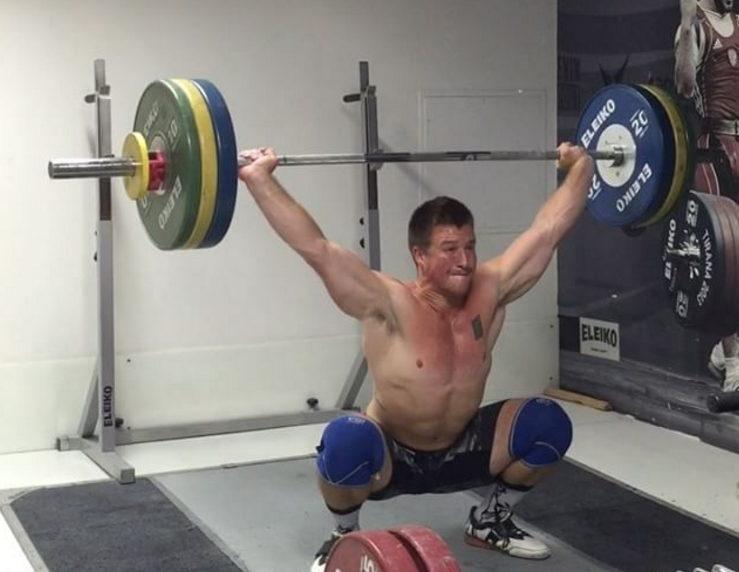
Olympic Weightlifting
Sometimes called “oly lifting” or just “weightlifting,” this is an Olympic sport that also focuses on your total: the maximum weight you can lift in two lifts, the snatch and the clean & jerk.
Both movements bring a barbell from the ground to overhead. The snatch uses one fluid (though fiendishly complicated) motion, the clean & jerk uses two: you lift the bar to shoulder height, then push it overhead.
It’s generally agreed that weightlifting is considerably more technical and requires more mobility, flexibility, speed, and balance than powerlifting. Many athletes spend months if not years before successfully executing a good snatch.
“Weightlifting can also have benefits over regular resistance training in that it’s incredibly anaerobic, requiring very short duration energy systems, and neuromuscular adaptations from Olympic lifting can translate to more muscle engagement and an ability to rapidly recruit muscle fibers to afford you stability,” sags Stephen Chao, a physical therapist at New York City’s Integrated Health Sciences. “If you’re on a bus and it suddenly jerks or twists, that needs a quick leg and hip reaction. I call that reactive stability, and it’s something most people tend to lose as they get older.”
Learn more in our introduction to weightlifting for the general population here.

CrossFit
A mishmash of disciplines, CrossFit aims for its athletes to be proficient in as many areas of fitness as possible: it includes powerlifting and weightlifting, but there’s also jumping rope, kettlebell swings, running, and even gymnastics. Workouts are often performed at a high intensity to also hone cardiovascular conditioning.
CrossFit is the most visible of the strength sports; you’re far more likely to have a CrossFit gym (or “box” as they’re often called) in your locale than a powerlifting gym.
While its annual competition, The CrossFit Games, has contributed to the sport’s image of ultra intense, human limit-pushing workouts, gyms are welcoming to folks of all levels of fitness and all good coaches can “scale” a workout to your needs. If box jumps are hard on your knees, for example, you can do box step ups, lunges, bodyweight squats, or something else you and your coach agree on.
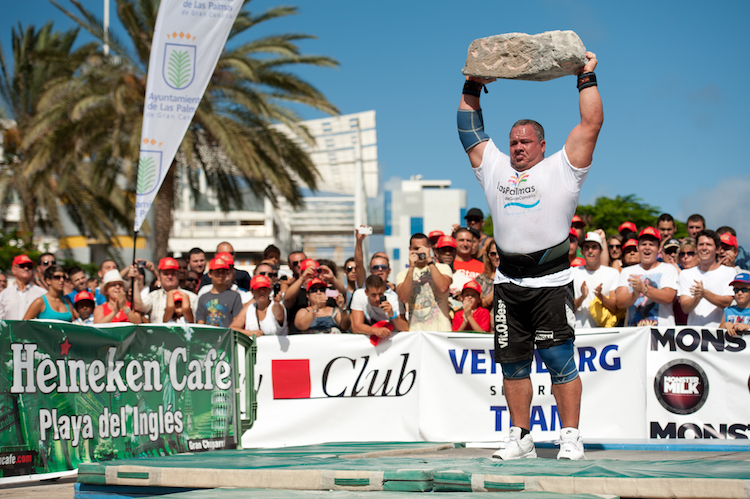
Strongman
The name may bring about images of men hauling airplanes with a harness. Like CrossFit, seeing the very top athletes competing on TV can make the sport seem less accessible than it is.
One might say strongman focuses on a lot of movements that a human might perform in the wild: lifting, dragging, and carrying unbalanced objects. It also includes lifting Atlas “stones” (actually smooth spheres), overhead pressing logs (actually thick bars), and powerlifting moves like back squats and deadlifts. Often there will be timed events, like loading several stones in a minute, so it includes more cardiovascular performance than powerlifting and Olympic lifting.
Because there’s a lot of unusual, unbalanced items, and because there’s a lot of focus on grip strength, some consider strongman more “functional” than the sports where you focus on perfectly balanced barbells.

Bodybuilding/Physique
While the goal of these sports are aesthetic, rather than performance-based, they’re sometimes considered strength sports given how much time they require in the gym. The idea is to build as much muscle and retain as little fat as possible within the parameters of your sub sport: bodybuilding emphasizes size a lot more than the physique category, for example.
There are myriad benefits to improving your body composition — your levels of muscle and fat — that a lot of research supports. That said, before competing on stage one typically reduces water intake and aims for body fat levels so low that they can produce extreme fatigue and hamper the production of hormones like testosterone. So while it can be a very healthy hobby, not many physicians love the idea of getting stage ready.
Other Strength Sports
This isn’t an exhaustive list of strength sports. Wife carrying is one, yes, but there’s also kettlebell sport, a cardio-heavy sport which involves swinging and pressing weights for high repetitions; arm wrestling, which is a tad less focused on full body performance; Mas wrestling is a Russian sport where two people fight over a stick… the list goes on. But let’s focus on those most accessible for you.
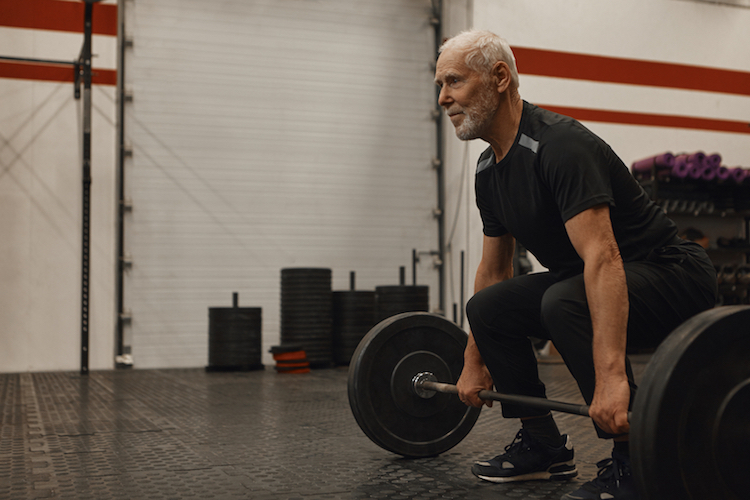
Benefits of Strength Sports for Older People
What might look like messing around in the gym can actually have profound benefits in all areas of your life.
Longevity
For many, it seems like the second you turn 30, your low back starts to hurt. Then your knees, then your hips… what’s the most common advice you hear to mitigate these issues? Load bearing exercises, a.k.a. strength training.
Strength training improves not only your strength — which helps you carry yourself better, improve posture, and reduce tension and pressure in spots like the lower back — research suggests that among senior citizens it can also slow the disintegration of white matter in the brain, which helps pass information between different brain regions and reduce the risk of Alzheimer’s disease. Fourteen weeks of lifting also saw significant reductions in blood cholesterol among women in their twenties, and other studies found it to produce better blood sugar, a lower heart rate, and stronger hearts.(1)
There’s even a (very complex) association between exercise and your genes, with some studies finding that getting stronger activated genes with beneficial impacts on inflammation, insulin response, energy metabolism, and immunity.(2)

“I think it’s really important that men and women 40 and up should be picking up weights,” adds Amy Mandelbaum, a masters CrossFit athlete and owner of CrossFit Westport. “Strength training improves bone density and muscle mass to protect bodies as they get older, because we lose calcium density and increase osteoporosis risk as we age.”
Sleep and Mental Health
We’re simply more prone to sleep and mental health issues as we age, and reams of studies have concluded that a regular exercise habit helps improve “all aspects of sleep” (especially sleep quality), reduce stress hormones, and lower the risk of depression.(3)(4)(5)
As alluded to above, it can even have benefits for learning capacity: more white matter means better communication between different regions of the brain, and other research has found it to increase what’s called “brain derived neurotrophic factor,” which helps to create new brain cells.(6)(7)
Goal Oriented
Strength sports aren’t like your standard gym classes where the goal is mostly to sweat and get tired. There’s nothing necessarily wrong with that, but the reason many find the sport aspect useful — be it against other athletes or against your own previous numbers — is that it provides motivation to measurably improve.
Strength sports give you goals to accomplish and provide motivation to stay on track with workout consistency, diet quality, stress management, sleep hygiene, and so on. Falling behind in these areas has concrete links to reduced performance at your sport because strength is very closely tied to your overall health.
Too much stress? Not enough sleep? Didn’t eat enough? Not getting enough leafy green vegetables? All of these are things you probably know you should be doing for your health, and if you’re not doing them, the weight on the bar is unlikely to keep increasing.
This isn’t to say strength sports make you feel guilty for not being healthy! Rather, your performance can be a useful metric for monitoring your overall health. Athletes often find that strength, particularly if they have a competition on the horizon (though this isn’t a requirement), helps to motivate them to keep improving in all areas of their life.

Community
There’s going to a gym and lifting on your own, and then there’s being in a group of people with similar goals. Not only can this help to keep you accountable for your own goals (remember how easy it is to forget your New Year’s Resolutions?) but finding a training partner, knowing the coach by name, or just feeling like this gym is one of your places — somewhere you know people, socialize, and work on a shared goal — can be a night-and-day difference with regard to how much you want to go and exercise.
At CrossFit, everyone does the same workout together. While you’re very free to modify it if, say, your knee is feeling crunchy that day, the fact that everyone is doing the same workout together — and CrossFit’s MO of having athletes engage with one another before the class begins in earnest — means the sport is well known for forging friendships.
But the same is true of the other strength sports. You might know this from your other endeavors in life, but a group of people working together to accomplish the same (or similar) goals fosters special bonds.
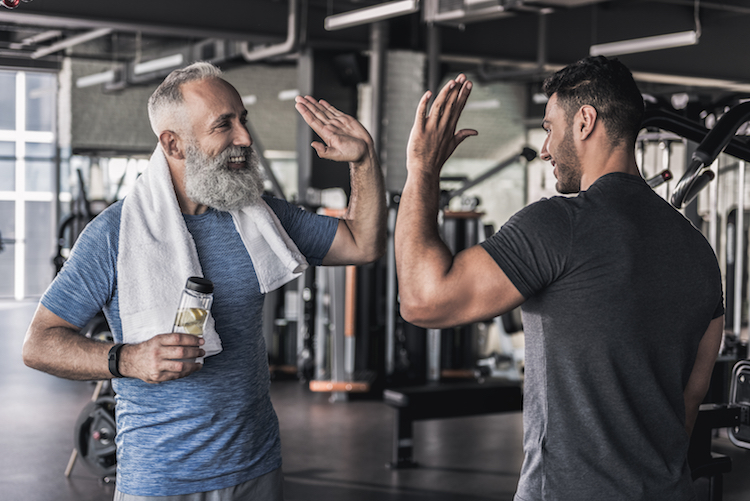
Training Considerations for Masters Athletes
Interested? Consider some preliminary steps.
Before You Train
After decades of not doing this sport (and likely sitting down for most of every day), the first thing you want to do before finding a coach is finding a physical therapist.
“People 35 and up are going to have life injuries, maybe they hurt their shoulder in school and didn’t get it fixed, maybe arthritis in hip,” says Mandelbaum. “Most people will walk in with some wear and tear on bodies.”
“The chances of those movement pattern dysfunctions at an older age are probably a little higher than they are at a younger age,” adds Mike Gattone, the Assistant Technical Director at USA Weightlifting. “People have injuries, people become dysfunctional by sitting at their office chair for 30 years, so a functional movement screening is definitely becomes a prerequisite.”
Find a physical therapist or orthopedic doctor and tell them of your plans so you can get a screening and know if there are any issues you should tell your coach about.
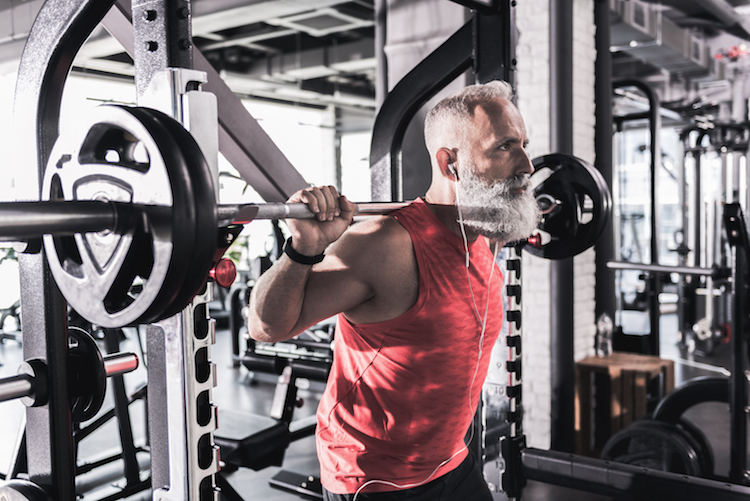
Training Frequency and Intensity
“I’d say for the absolute beginner to train a maximum of three days a week for one hour,” says masters strongman and coach Mike Gill, and that applies to any new strength sport. Training is like a hot bath: you want to slowly submerge yourself to avoid getting burned.
Focus on a few key movements for the first few months of training, and don’t forget to ask your coach to add in transverse and lateral movements as well: strengthening muscles that help you rotate and move side to side can go a long way to improving injury resistance.
For powerlifting, it’s spending one session per week on each of the three movements and their accessories, prioritizing whatever your movement screening suggested you focus on. (Hip mobility, for instance.)
For strongman, Gill suggests the log press, the farmer’s walk, and the stone load as foci for your three workouts for the first few months.
For weightlifting it depends a lot on your mobility. Weightlifters often start off working on the snatch one day, clean another, and the jerk on the last day. However, this all depends on your strength and mobility on day one.
“You’ll want to start light and probably start training with partial movements,” says Gattone. “For an older person, we might put the bar at the top of the thighs in the power position and maybe first start with some clean pulls from there as we progress toward the floor. And if they can’t catch a weight, there are options like a nice, explosive pull onto the balls of the feet with a good strong shrug. I think there’s a ton of efficacy for that in an older person.”

For CrossFit, the hour-long workouts vary by the day, but it’s important to make your needs known to your coach.
“It’s really incumbent on the athlete to do a constant self check when they’re in class,” says Mandelbaum. “If snatching’s in the workout and they’re not good at it, maybe there’s an old shoulder injury, they should be able to tell the coach they’ll do single arm dumbbell snatches or strict overhead presses instead. So you have to be self possessed in that situation. And don’t be afraid to take additional rest and recovery time.”
[Read More: The Best Weight Loss Programs]
Outside of the Gym
Particularly as Masters athletes, it’s worth remembering that the body is always recovering from your last workout and regenerating for your next one. These tips will help.
Mobility
This basically refers to how well your body can move and how easily you can get into important positions. For example, a good squat needs good mobility in the ankle, hips, and knees. Mobility requirements vary between sports: squatting with a barbell overhead, common in CrossFit and Olympic weightlifting, is one of the toughest movements in this regard but powerlifters don’t usually worry if they can perform it.
But more mobility is always good. It’s a vast topic that often starts with “sit in the bottom of a squat position for a few minutes a day,” but there are programs you can follow that will give you work you can do at home to improve mobility and lower your injury risk. Ask around forums like r/crossfit for routines that you can do in front of the TV in the evening or, as Mandelbaum likes, before a workout.
Nutrition
If progress and recovery matter to you (and they should) nutrition is a key component. Athletic training breaks down muscle, prompting the body to rebuild the muscle with more strength. Without adequate nutrition, the muscles simply won’t recover as well as they could, progress will stall, and many of the benefits of training — like better sleep and more energy — will be out of reach.
Strength sports aren’t especially unusual when it comes to sports nutrition, which generally follows the same rules no matter the sport: get plenty of protein and carbohydrates at each meal (athletes do not follow low carb diets) and don’t run too low in fat, about a “thumb”’s worth per meal. A protein shake and a banana between meals will probably help to get your calories in the right place.
“As people get over 40, lowering their sugar intake and increasing Omega-3 fatty acid intake is going to help prevent inflammation of the joints which is more powerful than you can do with any supplement,” adds Gill, a certified nutritionist.
To really get ahead, you might want to be more precise and track the amount of calories, protein, carbs, and fat you’re eating. The basic rule of thumb is 0.7 to 1 gram of protein per pound of bodyweight, at least 0.3 grams of fat per pound of bodyweight, and the rest of your calories should come from carbs.
We know this can sound complicated, so we devised a macronutrient calculator that will let you know the right amount of calories and so on that you should be eating, including tips for how to track. Get plenty of leafy green vegetables as well, and you’ll be in a good spot.
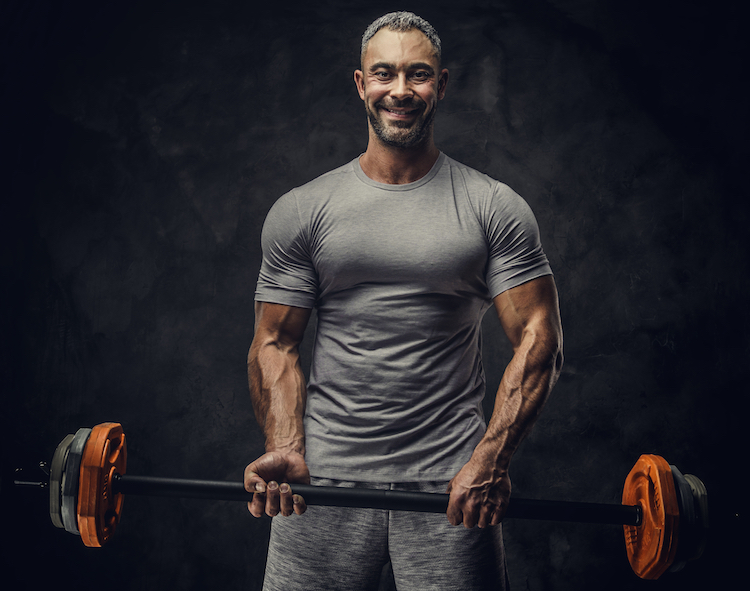
[Read More: Powerbuilding Workout Routine, With Tips from a CPT]
Finding a Coach
You’re embarking on a quest into unknown territory, so you need a guide. That’s why the right coach is of the utmost importance.
How easy it is to find a coach depends on your sport.
CrossFit
With CrossFit being the most widespread strength sport, you typically have a few gyms to choose from.
“Not all coaches are created equal,” says Mandelbaum. “The best thing to do is ask around, look at the website of gyms you’re considering and look at the coach bios. You want someone who understands biomechanics and has a history of coaching. That doesn’t necessarily mean a Games athlete.”
She adds that a benefit of CrossFit is that most gyms let you take a couple of classes for free, so you can see how you feel.
“Don’t just land in a CrossFit gym and call it home, test the waters in your area.”
Weightlifting
Weightlifting also stands apart because USA Weightlifting has scores of accredited gyms and coaches across the country, and many have experience working with Master’s athletes. A good bet is to send an email to USA Masters Weightlifting to see if they can recommend anyone in your area.
If there’s no one with experience with Master’s athletes, many gyms and CrossFit gyms have USAW-certified coaches that may be able to work with you, depending on the history you unearthed at that screening you went to. Be sure to interview a few different coaches to see which is best suited for your age and experience level.
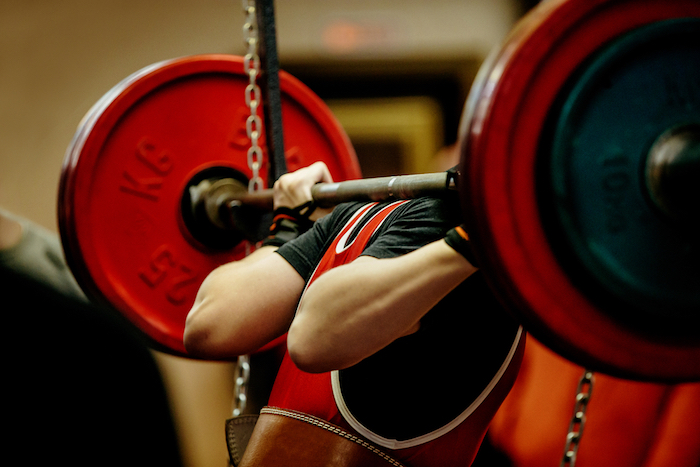
[Read More: The Best Upper Body Exercises and Workouts]
Powerlifting
Dedicated gyms for powerlifting are few and far between — Google them in your area and you may get lucky, but there’s good news if you don’t: getting stronger in the “big three” movements is something that most personal trainers are taught about.
Even a no name neighborhood gym likely has trainers who know what they’re doing when programming the lifts. Look for one who has worked with Masters age athletes, and/or try to find a Certified Strength and Conditioning Coach (CSCSC); they’re top tier in the PT game.
Call around a few gyms, and it might be worth checking out certified coaches from powerlifting organizations like the USPA and USAPL, although their networks for keeping track of coaches aren’t quite as robust as USAW.
[Related: Your Definitive Guide to Picking a Great Powerlifting Coach]
Strongman
Which brings us to the least robust coaching network: the sport of strongman. Despite all the money involved with the Arnold Strongman Classic and the World’s Strongest Man competitions, strongman is a notoriously low tech sport. Besides BarBend, there aren’t many great online resources for getting started in the sport.
Starting Strongman has an incomplete list of gyms by state, but most find that they wind up using remote training for the sport: they join a gym, buy equipment if it’s lacking, and follow programming from a coach online.
“Probably the best thing to do is ask on a trusted forum for referrals from other Masters athletes as to who their coach is,” says Gill, who offers his own online coaching. “Reddit is good, or ask around at competitions if you attend one.”
Wrapping Up
By now, you know that the sport of strength can offer myriad benefits ahead of simply doing bicep curls in an empty gym. Camaraderie, goal setting, and habit building are just some of the advantages that taking your fitness to a sport can offer. Make absolutely certain you speak to a physician and a physical therapist or orthopedic doctor before embarking on your journey. Take the bad days with the good and remember not to compare yourself to the 20-year-old lifting alongside you: in strength, you’re really just trying to be better than you were yesterday.
Resources for Masters Athletes
CrossFit
- CrossFit, Inc’s Official Guide to Training Masters Athletes
- Training Masters Athletes: Lessons on Goals, Volume, and Intensity – BarBend
- The Masters Guide to CrossFit – The Box
- CrossFit Gyms By State (Note that most gyms will hold their own competitions from time to time)
Powerlifting
- How to Start Powerlifting After 40 – BarBend
- Upcoming Powerlifting Meets – USAPL
- Upcoming Powerlifting Meets – USPA
- Upcoming Powerlifting Meets – World Powerlifting Congress
Weightlifting
- How to Start Olympic Lifting After 50 – BarBend
- USA Weightlifting’s Masters Page
- Sample Masters Training Program – Catalyst Athletics
- 4 Tips for Masters Weightlifting – BarBend
- Upcoming Local Weightlifting Meets – USA Weightlifting
Strongman
- Strongman Training Over 40 Years Old – BarBend
- Strongman Gyms By State (Incomplete) – Starting Strongman
- 3-Hour Strongman: How to Stay Strong On Limited Training – BarBend
- The 5 Most Important Movements in Strongman – BarBend
- Upcoming Strongman Competitions – United States Strongman
- Upcoming Strongman Competitions – Strongman Corporation
References
1. Prabhakaran, B et al. Effect of 14 Weeks of Resistance Training on Lipid Profile and Body Fat Percentage in Premenopausal Women. Br J Sports Med . 1999 Jun;33(3):190-5.
2. Dongmei, L et al. Skeletal Muscle Gene Expression in Response to Resistance Exercise: Sex Specific Regulation. BMC Genomics. 2010 Nov 24;11:659.
3. Kovacevic, A et al. The Effect of Resistance Exercise on Sleep: A Systematic Review of Randomized Controlled Trials. Sleep Med Rev . 2018 Jun;39:52-68.
4. Kraemer, W et al. Effects of Heavy-Resistance Training on Hormonal Response Patterns in Younger vs. Older Men. J Appl Physiol (1985) . 1999 Sep;87(3):982-92.
5. Murri, M et al. Physical Exercise in Major Depression: Reducing the Mortality Gap While Improving Clinical Outcomes. Front Psychiatry. 2018; 9: 762.
6. Molteni, R et al. A High-Fat, Refined Sugar Diet Reduces Hippocampal Brain-Derived Neurotrophic Factor, Neuronal Plasticity, and Learning. Neuroscience . 2002;112(4):803-14.
7. Gilland, K et al. Effect of Food Deprivation or Short-Term Western Diet Feeding on BDNF Protein Expression in the Hypothalamic Arcuate, Paraventricular, and Ventromedial Nuclei. Am J Physiol Regul Integr Comp Physiol . 2017 Apr 1;312(4):R611-R625.
Featured image via Olena Yakobchuk/Shutterstock